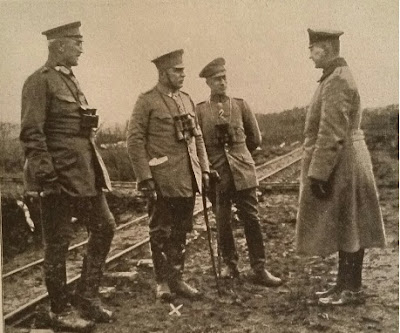After Two Years
Two years of world war lie behind us. Contrary to all theories from political and economic experts on the anticipated duration of a modern war, world history has brought us this formidable experience - two years of world war and still no end in sight.
 |
| Field telephone |
Two years of world war. How much lies behind these five simple words! Enthusiastic heroism, adolescent zest, the manly, earnest performance of duty, loyal cameraderie to the death, proud joy and deep sorrow and much silent forsaking and painful sufferance. This is war. The memory of those first August days of 1914 remain unforgettable. When the German youth flocked to arms in droves, when they marched with melodious songs on their lips, when the entire German people forgot everything that separated them in unanimous patriotic enthusiasm and stood as one man against the enemy... and then came the days when our army roared through Belgium and Northern France like a storm wind and "the German cavalry rode almost to Paris". And the days when Hindenburg chased the murderous Russian troops out of Eastern Prussia and drove them back deep into their own country. And then came the days of trench warfare, when our armies stood in the East and the West as a protective wall of iron and fire in enemy territory, so that no enemy soldier would ever tread on our home soil. Until this spring the brave soldiers were called to new attacks and to defend the territory gained with fearless resistance.
Two years of world war. What our troops have achieved and endured in this time cannot be put into words. Even the boldest imaginings of those at home cannot visualize what this war is in reality and what it demands from leaders and troops. We are only able, with extreme gratitude, to remember those who have achieved almost superhuman accomplishments. Who, with unprecedented courage, have held off the enormous dominance of the enemy from our borders, so that life in the homeland has continued as calmly as during peacetime. Let us also remember the sons of our people who gave their utmost - their lives - for the motherland, for us.
Two years of world war! And in the homeland, we were not without our sacrifices. Particularly when the enemies send the hunger devil into our homes, because they realize their own military impotence. Be that as it may! Those at home can and want also to make sacrifices; besides, how negligible these are, compared with the sacrifices being made out there. They will not starve us out and we will not become faint-hearted, even if things become scarcer than in peacetime. We will survive!
Two years of world war! And no trampled fields in the homeland, no burnt down villages, no devastated towns, no enemies in our country! Is that not a proud, uplifting thought, considering that half the world is against us? From a military perspective, they will not defeat us; from an economic perspective, they might be able to create difficulties for us, but they cannot starve us and the mood of the people and the army remains unbroken. These are the three strong roots of our strength to persevere, even in the third year of war.
We do not know whether the war has reached its climax. Undoubtedly, the efforts of our opponents have never been more formidable than at this time. This requires heroism and courage out in the field and unity and solidarity at home. So let us cease our grumbling, only one will and one deed shall prevail - stay strong!
Stay strong! Frederick the Great once wrote in the 7 Years' War: "I have high hopes and no matter how great the number of my enemies, I trust in my good cause, in the admirable bravery of the troops, and in their good will from marshal to the lowest soldier." In this trust, the homeland greets the armed forces. In this trust, let us hold together at home, so that everything will lead to a good end. This is our pledge on the second anniversary of the world war.






































